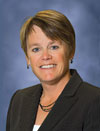
Engage kids early on by visiting schools to talk about the joy of a career in packaging.
Career opportunities in packaging are varied-from package de-sign, material science and engineering to sales and marketing-and salaries are competitive. Yet in the eyes of many high-school and college students, packaging as a career remains a well-kept secret.
An incoming supply of young workers is the lifeblood of any industry. What can we, as an industry, do to attract students into these rewarding careers? Many companies, schools and individual professionals are actively reaching out to attract young people into packaging careers.

Jennifer Sagert
Missionary work
Many companies participate in college packaging internship programs such as the one offered by the University of Wisconsin-Stout.“These paid internships,” reports Robert Meisner, Certified Packaging Professional (CPP), assistant professor of packaging at UW-Stout and vice president, Certification, Institute of Packaging Professionals (IoPP), “offer excellent hands-on experience.”
One feature of the Stout internships is that students who have completed their internships are encouraged to visit high schools to talk to students about careers in packaging.
“They talk about their experience and about packaging careers,” Meisner says. “That youth-to-youth connection seems to carry more weight than the recommendations of career counselors.”
One of those UW-Stout students was Jennifer Sagert, CPP, currently a packaging scientist with Hormel Foods in Austin, Minnesota.
“My introduction to packaging was accidental. I met students at UW-Stout who were enthusiastic packaging majors. That led me eventually to major in packaging. I was especially impressed that the job placement rate for packaging majors was close to 100%.”
Following her internship, Sagert returned to her high school and spoke with juniors and seniors about packaging as a career.
“My own ‘discovery’ of packaging made me enthusiastic about sharing with younger people the career challenges and opportunities it offers.”
Sagert believes that the colleges with packaging programs can do more to encourage high-school students, perhaps by hosting a day when they can work with the college students to design a package.

June Anderson
Growing career opportunities
As a high-school student, June Anderson attended a presentation about the programs offered by Michigan State University, buried among which was information about the School of Packaging. Later, as a student at Michigan State beginning to study computer science, she remembered that presentation when she realized that computer science was not for her.“I took my first packaging class, and that was it! It was what I was looking for. The program combined technical and business classes and it made sense from the beginning.”
Following years of working in consumer and industrial packaging, Anderson (who is a CPP and a current instructor of IoPP’s Fundamentals of Packaging Technology as well as a former IoPP Board Member) is now a consultant whose company, Packaging Knowledge Group, provides training to help companies meet the requirements of the Wal-Mart sustainable packaging scorecard.
This term she will be reaching out to young people by teaching Introduction to Packaging at Michigan State. Like most of the professionals interviewed here, she also visits high schools to talk about careers in packaging.

Jane Chase
Reaching younger students
Jane Chase is currently president of IoPP and has been chair of the industrial advisory committee to the packaging program at UW-Stout for the past five years. Her career has involved em-ployment with companies as diverse as Johnson Wax, ConAgra, General Mills and most recently U.S. Foodservice, all of which have maintained outreach to students through college internships.“Student internships were key to each of those companies,” she states.
Personally, she often participates in Career Day at high schools. When she does, she takes along a common package, like a bottle with a finger pump.
“I ask how many parts they think the package has, then we take it apart, and they see how much more there is than meets the eye. That leads into a discussion of how many companies and how many people were involved in designing and making that bottle.”
That then leads into a discussion about career opportunities in packaging.
The IoPP contribution
Once they become packaging students, IoPP has several ways to feed their interest and help connect them to the active professionals in the industry.Students can become members of IoPP for a reduced fee of $17.50 per year. Most local IoPP chapters near colleges with packaging degree programs have close connections to the student IoPP chapters on campus. They invite the students to their meetings where they can network with professionals and also learn about the reality of day-to-day work in packaging.
In 2009, a new competition devised by IoPP regional vice president Bret Carlson, CPP––the Student AmeriStar Awards––will honor student achievements in packaging.
“Honoring outstanding achievements in packaging with IoPP’s AmeriStar Awards has raised the visibility of packaging in industry and among the public,” says Carlson, engineering services director for Orbis Corp. “We wanted to do the same thing for students.”
As the need grows…
When June Anderson graduated from the Michigan State School of Packaging in the 1980s, there was a shortage of jobs in packaging. In contrast, today’s companies find it hard to find enough qualified packaging specialists. Jane Chase confirms this gap between demand and supply.“As president of IoPP,” she says, “I am often contacted by large companies that are having trouble recruiting packaging professionals.”
To meet this increasing demand, the number of packaging students needs to increase. Student numbers will increase only as interest in packaging as a career is generated among grade-school and high-school students.
Chase believes that the degree to which packaging professionals talk about packaging in their daily lives, to their neighbors and friends, has a much greater effect than we realize. More packaging professionals need to visit schools, perhaps with the support of their companies, to talk about careers in packaging.

